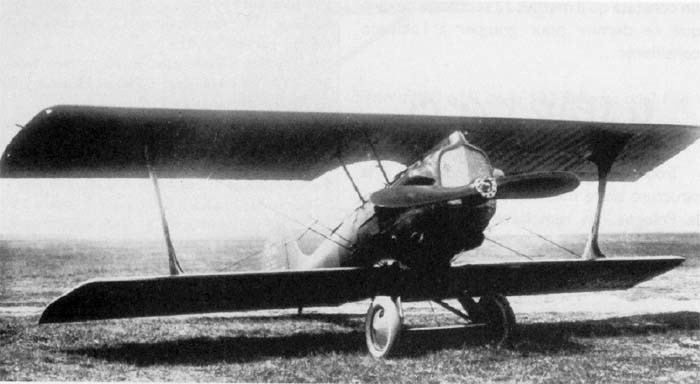The Blériot-SPAD S.61 was a French fighter aircraft developed in 1923. Designed by André Herbemont, the S.61 was a conventional biplane, abandoning the swept upper wing used by Herbemont in several previous designs. The prototype S.61 was evaluated by the French Air Force alongside the S.51 as a potential new fighter, but like its stablemate, was rejected. The Polish Air Force (which had also purchased the S.51) was impressed enough to order 250, as well as purchase licences for local production. The Romanian Air Force also ordered 100 aircraft. About 30 were built in Poland, by the CWL (Centralne Warszaty Lotnicze - Central Aviation Workshops, a predecessor of PZL).
Apart from their military service, S.61s were used in France for racing and record-setting attempts. On 25 June 1925, Pelletier d'Oisy won the cross-country Coupe Michelin in an S.61, and another of the type won the 1927 competition and was placed second in 1929. An S.61 was also used by Jean Callizo in his fraudulent attempt on the world altitude record that saw him stripped of his Légion d'Honneur. A Polish S.61 placed second in the Capitaine Echard race at the Zürich aerial meeting in 1927.
The S.61 (known in Poland simply as Spad S.61) had a poor reputation in Poland due to numerous crashes, many attributed to a weak wing mounting. During the period from 1926 to 1931, 26 pilots were killed while flying the S.61.
S.61/1
prototype for French evaluation, powered by a 320 kW (430 hp) Lorraine-Dietrich 12Ew W-12 engine with supplementary supercharger.
S.61/2
production version for Poland and Romania, powered by a 340 kW (450 hp) Lorraine-Dietrich 12Ew W-12 engine with supplementary supercharger.
S.61bis
converted S.61/2, powered by a 320 kW (430 hp) Lorraine-Dietrich 12Ew W-12 engine with supplementary supercharger.
S.61/3
single machine with reduced wingspan, powered by a 320 kW (430 hp) Lorraine-Dietrich 12Ew W-12 engine with supplementary supercharger.
S.61/4
single machine with a 360 kW (480 hp) Lorraine-Dietrich 12Ee W-12 engine
S.61/5
three machines with a 340 kW (450 hp) Hispano-Suiza 12Gb W-12 engine
S.61/6
racer prototype converted from the S.61bis, powered by a 320 kW (430 hp) Lorraine-Dietrich 12Ew W-12 engine with supplementary supercharger.
S.61/7
Powered by a 340 kW (450 hp) Lorraine-Dietrich 12Eb W-12 engine, with Rateau supercharger for world altitude record attempt
S.61/8
A single S.61/5 refitted with a 370 kW (500 hp) Hispano-Suiza 12Hb V-12 engine.
S.61/9
single S.61/6d modified for 1929 Coupe Michelin race, powered by a 170 kW (230 hp) Lorraine 7Ma Mizar radial engine.
S.61 Ses
(Ses for Sesquiplane) This was the final version of the Bleriot S.61, fitted with seaquiplane wings, powered by a 340 kW (450 hp) Lorraine-Dietrich 12Eb W-12 engine. (1 built).
Poland
Polish Air Force
2nd Fighter Regiment
3rd Fighter Regiment
4th Fighter Regiment
11th Fighter Regiment
Romania
Royal Romanian Air Force
Soviet Union
Soviet Air Force - One aircraft, used for tests and trials.
General characteristics
Crew: one pilot
Length: 6.98 m (22 ft 11 in)
Wingspan: 9.57 m (31 ft 5 in)
Height: 2.90 m (9 ft 6 in)
Wing area: 29.3 m2 (315 ft2)
Empty weight: 1,055 kg (2,326 lb)
Gross weight: 1,565 kg (3,450 lb)
Powerplant: 1 × Lorraine-Dietrich 12Ew, 336 kW (450 hp)
Performance
Maximum speed: 227 km/h (141 mph)
Range: 603.5 km (375 miles)
Service ceiling: 7,500 m (24,605 ft)
Rate of climb: 6.9 m/s (1,360 ft/min)
Armament
2 × fixed, forward-firing .303 Vickers machine guns

